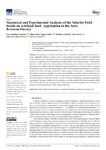Mostrar o rexistro simple do ítem
Numerical and experimental analysis of the velocity field inside an artificial reef. Application to the Ares-Betanzos estuary
| dc.contributor.author | Santiago Caamaño, Lucía | |
| dc.contributor.author | Lamas, M.I. | |
| dc.contributor.author | Carballo, Rodrigo | |
| dc.contributor.author | López, I. | |
| dc.contributor.author | Cartelle Barros, Juan José | |
| dc.contributor.author | Carral Couce, Luis | |
| dc.date.accessioned | 2023-03-23T13:01:52Z | |
| dc.date.available | 2023-03-23T13:01:52Z | |
| dc.date.issued | 2022-11-28 | |
| dc.identifier.citation | Santiago Caamaño, L.; Lamas Galdo, M.I.; Carballo, R.; López, I.; Cartelle Barros, J.J.; Carral, L. Numerical and Experimental Analysis of the Velocity Field Inside an Artificial Reef. Application to the Ares-Betanzos Estuary. J. Mar. Sci. Eng. 2022, 10, 1827. https://doi.org/10.3390/jmse10121827 | es_ES |
| dc.identifier.issn | 2077-1312 | |
| dc.identifier.uri | http://hdl.handle.net/2183/32751 | |
| dc.description.abstract | [Abstract]: The placement of artificial reef (AR) units on the seabed modifies the velocity field of the water, making the nutrients circulate properly and creating the necessary habitat for the settlement of the desired species. This paper proposes a methodology for determining the circulation in the vicinity of one specific AR unit module previously defined in the existing literature. This has been based on both the application of three-dimensional hydrodynamic criteria and computational fluid dynamics (CFD) together with their validation using towing tank tests. In order to achieve the goals, the starting points are both the initial design of the AR units and the 3D hydrodynamic circulation model in the estuary. The latter predicts the nutrient supply to each module by taking into account the variation of speeds with height. From the vertical profile of circulation velocities, developed for each implantation site, a CFD tool is used to determine the circulation of nutrients in the vicinity of the AR unit, around 5 times the AR size. Then, the results are validated by carrying out towing tank experiments. The main contribution is to combine a circulation model of the estuary together with a CFD model validated with towing tank tests. Although this work was applied to the Ares-Betanzos estuary, it can be extrapolated to other zones worldwide. | es_ES |
| dc.description.sponsorship | Xunta de Galicia ; CN-10MMA003CT | es_ES |
| dc.language.iso | eng | es_ES |
| dc.publisher | MDPI | es_ES |
| dc.relation.uri | https://doi.org/10.3390/jmse10121827 | es_ES |
| dc.rights | https://creativecommons.org/licenses/by/4.0/ | es_ES |
| dc.rights.uri | http://creativecommons.org/licenses/by/3.0/es/ | * |
| dc.subject | Artificial reef | es_ES |
| dc.subject | Coastal dynamics | es_ES |
| dc.subject | Computational fluid dynamics | es_ES |
| dc.subject | Towing tank test | es_ES |
| dc.title | Numerical and experimental analysis of the velocity field inside an artificial reef. Application to the Ares-Betanzos estuary | es_ES |
| dc.type | info:eu-repo/semantics/article | es_ES |
| dc.rights.access | info:eu-repo/semantics/openAccess | es_ES |
| UDC.journalTitle | Journal of Marine Science and Engineering | es_ES |
| UDC.volume | 10 | es_ES |
| UDC.issue | 12 | es_ES |
| dc.identifier.doi | https://doi.org/10.3390/jmse10121827 |
Ficheiros no ítem
Este ítem aparece na(s) seguinte(s) colección(s)
-
CIT-GII - Artigos [38]
-
GI-GRIDP - Artigos [12]
-
GI-SISTER - Artigos [37]






